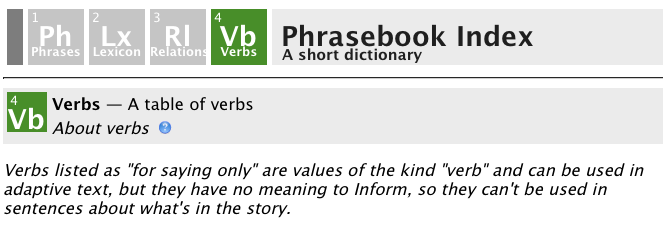I have some confusion regarding Verbs, and this confusion spans two chapters. So, technically, this reply is not just about Relations and Sentence Verbs, but also about Chapter 14. Adaptive Text and Responses: §14.3 More on adapting verbs.
Regarding the Index, and specifically, the Phrasebook Index - 4. Verbs. The description text states:
I am confused by the phrase ‘Verbs listed as “for saying only”…’. Is the phrase “for saying only” supposed to show up in this index somewhere? Because that would be helpful in distinguishing between Sentence Verbs that are connected to a relation and Sentence Verbs that are used for Adaptive Text and Responses. But I don’t see that phrase anywhere.
Here’s what I do see:
For Sentence Verbs that are used for Adaptive Text and Responses, defined like this:
To achieve is a verb.
The index lists them like this:
For Sentence Verbs that are connected to relations (are they actually called “Assertion Verbs”?), defined like this (example from documentation sample code):
Suspicion relates various people to one person.
The verb to suspect means the suspicion relation.
The verb to be suspicious of means the suspicion relation.
The index lists them like this:
Now, I see that to achieve has an ellipses after it and nothing else. Was there supposed to be a “for saying only” string after the ellipses? On the other hand, to suspect does have its associated relation the suspicion relation listed after the ellipses.
So, there is a way to distinguish between these two Sentence Verb scenarios, but there still seems to be some sort of documentation bug. FYI, I’m on a Mac, maybe it is just a Mac problem.
My other point of confusion is what I should be calling these Verbs. Are both “Sentence Verbs” except, in one case, they use an association with a relation and in another case they don’t? Are the Sentence Verbs associated with a relation actually called “Assertion Verbs”? The difference between these two behaviors feels significant enough to warrant more specific names.


